Text & Photos : Manjira Manjumdar
In her essay, Manjira Majumdar drives home the point that Darjeeling has much more than its beaten-to-pulp sobriquet Queen of the Hills. Beyond its ubiquitous hills endowed with its spectacular beauty, there are quaint places around that expose visitors to, among other things, mystic climes, iconic monasteries and the abode of Lamas that are steeped in colonial history.

Over time, Darjeeling as the queen of the hills has been done to death. Just like any other hill station, with too much exposure and crowds trying to do the old and familiar. But to people who love to discover a place anew, there’s so much you can still do and pack in if you do it your way. Mix the old with the new, try to understand the local sensibilities and rejuvenate.
There are a few places more that have been developed to take the rush away from the main hill station so that it makes sense to detour and spend a couple of days or more at a nearby village of your choice. These small villages with a view offer home stays that have mushroomed but in select places.
With wholesome food and transport offered to customise your trip, you can easily pack in a couple of spots more.
You can undertake a day trip to Kalimpong to enjoy the flowers or to Darjeeling to soak in the ambience of the unique Chowrashta, Buddhist monasteries, old schools and churches, Nepali and Tibetan snacks, bakery items and of course, Darjeeling tea are some of the broader brushworks. Some iconic shops continue to sell Tibetan art which you can browse through if not buying.
Once upon a time, the golden triangle was Kurseong, Kalimpong and Darjeeling. A mandatory visit to Tiger Hill to watch the spectacular sunrise formed part of the must-dos.
But now there are options of bird watching, an orange farm walk through and views of rivers Teesta meeting Rangit in what is termed as the Lover’s Point. A few miles down the Teesta offers river rafting, but I leave that to the more adventurous.
A stopover at Siliguri
After you have reached Bagdogra airport or NJP (New Jaipalguri ) station by the newly introduced bullet train Vande Bharat that has cut down the journey by almost five hours, you can negotiate your trip to whichever place you wish to stay up in the hills. Usually the homestay owner organises transport for you.
My experience tells me that it is better to halt for a day at Siliguri, the corridor to the hills, before making that uphill journey. Vande Bharat reaches in the afternoon so there is nothing much you can do on that day.
I travelled in the season of mist that is March-April, which can make visibility almost nil despite the sun peeking on and off from the clouds. Of course the hill drivers know the roads like the back of their own hands but reaching by late afternoon than late evening is a better option. Of course, there is nothing you can do if there is a spell of rain that also creates a haze.
Siliguri, once a hot and dusty small town, today has expanded with smart buzzing cafes and for those who wish to fine dine, there is a City Centre Mall, besides a number of smaller good eateries. Maybe it could do with some art galleries and boutiques than just the Hong Kong market where cheap Chinese stuff is sold.

Lamahatta – the abode of lamas
From Siliguri you can head out to Doars, Sikkim, Bhutan etc. I head towards Tinchuley known for its pristine view of three peaks. It takes about three hours and though it is not yet late in the evening, the sun has already set. After tea and snacks, I make plans to visit Lamahatta the next day. Since Vande Bharat leaves early morning from Howrah, I am a bit exhausted though the mountain air has already worked its magic and energised me to a great extent to look forward to the dinner cooked at the guest house. The sky is suddenly clear with stars twinkling and a big full moon.
At Lamahatta, there is a beautiful artificial lake inside the “woods dark and deep” with pine, dhupi and cardamom trees encircling the lake like sentries holding watch. It is an eco-park.
Lamahatta literally means abode of the lama or Buddhist monk, so serene and peaceful it is. There are prayer flags fluttering in the breeze.
In and around Tinchuley there are small crowded markets selling everyday provisions. One hopes that without spoiling the area, small tea cafes come up for which walkers can stop by for a cup of tea.
I get that at Bara Mangwa. On my way from the bird’s eye view of the two rivers that are of a different colour each to become a third colour as they meet at Lover’s Point, the view is undoubtedly spectacular; like narrow ribbons crisscrossing each other.
Further ahead at Triveni Sangam, there are camps on the river bed of the Teesta while white water rafting is offered. I sit and observe as the Teesta flows by. But I do stop by at the Nirmal Orange Farm at Bara Mangwa en route to finally get my cup of tea to be enjoyed out in the open.
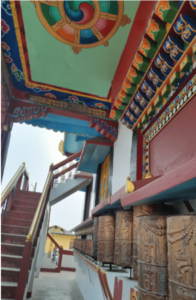
Pravash Pradhan, the farm owner has been growing organic oranges in his orchard here and takes visitors through it. It is better to do that when the oranges ripen because the April sun is warm. The best time to do this is the winter season – months of November and December.

Nevertheless surrounded by clumps of the red Fairy’s Horn flower, it is a lovely to shop at the little boutique for picking up orange and ginger teas, orange marmalade, ginger jam and dalle ( a fruit that can taste hot to very hot) sauce for things to carry back as gifts.
I round off with a cup of orange tea myself served in a teapot and enjoy it sitting in the shade with the sun on my back. I discover a little bit of paradise on earth. Fruit beer made of fresh oranges is available too.
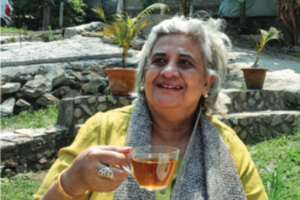
On a monastery trail
(Look for Old Ghoom monastery) Inside pix use given by the author…
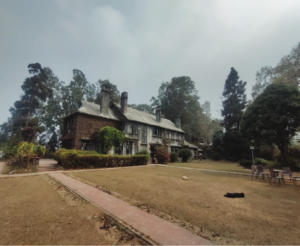
Kalimpong by contrast is much smaller as I had the opportunity to visit it a week earlier due to some work. Only one and half hours away from Tinchuley, I had, however, taken the Siliguri route, which was roughly three hours.
I visited the Buddhist monastery here where time indeed stops. On the way, I had passed a huge figure of Buddha; the monastery, however, is dedicated to Dudjum Rinpoche and was built by Norbu Sherpa at the original site established in 1946. .
You can do a gumfa or monastery trail. There are several in the region, including the Old Ghoom Monastery that falls on the way to Darjeeling. The external façade of this beautiful monastery, belonging to the Yellow Hat sect or Gelupka, was built by a Mongolian astrologer Sokpo Sherab Gyatso in 1850. So old are the Buddhist monasteries in the region and the Buddhist-Tibetan influences!
Doing this segment of the journey to Kalimpong with a friend, who had insisted we stay at a nice hotel than Morgan House, which is old and has a colonial history.
The hotel did offer a spectacular view but mist-laden nonetheless. The sunshine next day made up for that as we went to Deolo Park. Roadside eateries were selling steamed momos, small but extremely sweet oranges and little squares of steamed cakes made of peas flour. These are known as fampi in local dialect and served with a spicy coriander chutney.
The monastery at Kalimpong closes at around noon but the young monk opened the gates for us. It was so colourful with yellows and red dominating. There were tangkha scrolls depicting the Buddhist interpretation of gods and goddesses. No photos of interiors are allowed.

In addition, in Kalimpong, one can visit the Orchids Park, the Kali and Hanuman temples and lunch at Morgan House with prior notice. Morgan House looks like a frame out of a Victorian era. The cottage built by one Mr Morgan for his wife is said to be haunted! The creepers outside the cottage and the large windows transport you to the British Raj era and the rolling grounds all around it makes it resemble an estate in the English countryside.
A delicious lunch of dal, chawal and chicken stew drove any fear of ghostly apparitions away but one cannot vouch for night time, when doors are said to shut suddenly, and lights go off with a sighting of Mrs Morgan!
The Queen springs a surprise
Finally, after all this travelling, I pay respect to the Queen sitting at almost at an elevation of a little over 7, 000 feet over sea level. My plan was to visit Darjeeling strictly for a day. There is more than one route to Darjeeling and little trains (not toy train) chug along this route of Tung, Sonada and Ghoom to connect it to Darjeeling town.
The locals depend on this form of transport as tourists whizz past in cars and buses. Busy as ever on Good Friday, or maybe because it is a holiday, there is terrible traffic congestion. Everyone is out and seems to be having a good time; the locals and the tourists. This is the biggest town with a bigger railway station.
For someone who is not interested in trekking or hiking, a day in Darjeeling is something I am looking forward to not having visited it in years. I set up myself for disappointment as was the case in my previous two visits taken a decade apart.
But this time, I am pleasantly surprised. Yes, the main centre of the town – the mall – is gradually getting crowded and as summer comes, it starts to resemble busy parts of Kolkata it is joked. But today the sky is a lovely azure blue and the sunshine is soft on your skin. There is a bracing breeze and people are generally having a wonderful time.
The shops that once cluttered the main thoroughfare are cleared out and cars need to be parked a little distance away making space for walkers.
I do the usual. Lunch at Glenary’s known for its continental menu, an array of confectionaries and cakes. I browse the iconic Oxford Book Store and generally admire the shawls being sold by the wayside.
As the sun starts to fade it is time to head back and the driver takes me back through a quicker route.
Tomorrow I will leave for the plains after a nice quick holiday. I missed the snowy peaks of Kanchanjanga in its silver snowy glory, lit up just a bit golden in the morning, but found peace and tranquility in my heart.
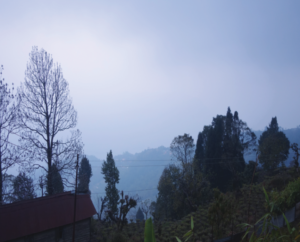
In short, with some planning, one can have a little bit of everything. Or you can just remain at a tea estate bungalow, now refurbished open to public, and imbibe a tea culture.
Darjeeling in India’s West Bengal state is geographically located in the Himalayan foothills in the east. Once a summer resort for the British, it is known for the narrow-gauge Darjeeling Himalayan Railway, or Toy Train, completed in 1881.
It still runs and goes up to Siliguri at its own slow pace and has a charm all its own as filmed in various Bollywood films.
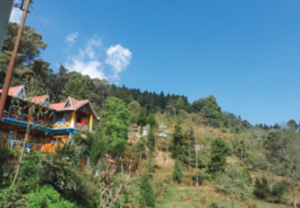
Darjeeling tea known for its various flushes – first, second and third – are exported worldwide and have gained the GI tag, the first Indian product to do so.

The many tiered tea shrubs add a lush beauty to the already green landscape. The entire region is hard to define as a single homogenous identity – the Nepali culture dominates but relics of the British Raj linger on, with many iconic houses belonging to the Bengali elite. Churches, temples and gumfa co-exist.
Almost every cottage has rows of tubs of colourful flowers adorning the balcony in front. Tea is served in a cup that comes with a cover so it does not get cold and with every night fall, strains of the guitar mingle with pahari songs.
Watching the sun rise and set in stills a sense of calmness. It is all about acceptance of life with all its trials and tribulations. The hills are alive with the sound of music.
Are we listening?
Manjira Majumdar is an independent journalist, part time researcher, guest lecturer and gender activist. Now surrounded by books, house plants, cats, she has recently edited an anthology of stories on partition and displacement: NO RETURN ADDRESS. She hopes to bring all her experiences together to write more books, both fiction and non-fiction.

